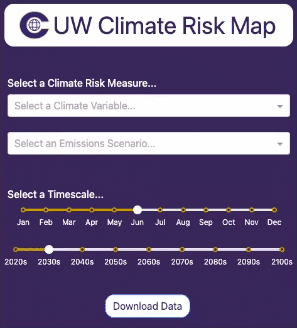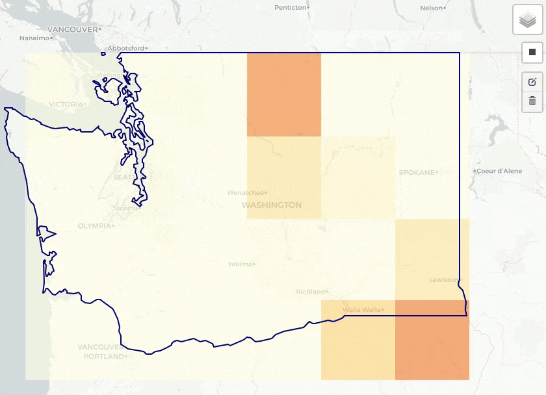CRL Map: Difference between revisions
Jump to navigation
Jump to search
mNo edit summary |
update formatting |
||
| Line 17: | Line 17: | ||
== | == Quick-Start Guide == | ||
Follow this step-by-step guide for a basic overview of the map functionality. The map can be accessed '''here'''. | Follow this step-by-step guide for a basic overview of the map functionality. The map can be accessed '''here'''. | ||
=== 1. Selecting Climate Scenario Parameters === | === 1. Selecting Climate Scenario Parameters === | ||
First, we need to select a combination of parameters for the desired climate scenario. | First, we need to select a combination of parameters for the desired climate scenario. | ||
{| class="wikitable" style="width:100%;" | {| class="wikitable" style="width:100%; border: 0; background: #f9f9f9;" | ||
|- | |- | ||
| style="width:50%; vertical-align:top;" | | | style="width:50%; vertical-align:top; border: 0;" | | ||
*'''Select a Climate Risk Measure''': Start by choosing a climate metric of interest from the drop-down menu. These are climate hazards curated by our team that may pose potential risks to infrastructure. | *'''Select a Climate Risk Measure''': Start by choosing a climate metric of interest from the drop-down menu. These are climate hazards curated by our team that may pose potential risks to infrastructure. | ||
| Line 37: | Line 37: | ||
<div style="text-align: center;">''The example on the right illustrates a scenario where the selected measure is "% Area Covered by Burnt Vegetation"—used as a proxy for wildfire risk—under a moderate emissions projection for August in the 2060s.'' </div> | <div style="text-align: center;">''The example on the right illustrates a scenario where the selected measure is "% Area Covered by Burnt Vegetation"—used as a proxy for wildfire risk—under a moderate emissions projection for August in the 2060s.'' </div> | ||
| style="width:50%; vertical-align: | | style="width:50%; vertical-align:center; text-align:center; border: 0; background: #f9f9f9;" | | ||
<div style="display: flex; justify-content: center;"> | <div style="display: flex; justify-content: center;"> | ||
[[File:Crl-map-select-dropdowns-small-2024-10-7.gif|alt=Dropdown Selectors]] | [[File:Crl-map-select-dropdowns-small-2024-10-7.gif|alt=Dropdown Selectors]] | ||
| Line 50: | Line 50: | ||
| style="width:50%; vertical-align:top; border: 0;" | | | style="width:50%; vertical-align:top; border: 0;" | | ||
*'''Select Infrastructure Overlays''': On the right-hand side, you'll see a layers icon. Hover over it to reveal the available infrastructure overlays. In this example, the available infrastructure includes specific types of power grid data, which provides insight into its exposure under the selected climate scenario. | *'''Select Infrastructure Overlays''': On the right-hand side, you'll see a layers icon. Hover over it to reveal the available infrastructure overlays. In this example, the available infrastructure includes specific types of power grid data, which provides insight into its exposure under the selected climate scenario. | ||
<div style="display: flex; justify-content: center;"> | <div style="display: flex; justify-content: center;"> | ||
[[File:CRL-Map-Infrastructure-Overlay-2024-10-7.gif|alt=Dropdown Selectors]] | [[File:CRL-Map-Infrastructure-Overlay-2024-10-7.gif|alt=Dropdown Selectors]] | ||
Revision as of 20:23, 8 October 2024
Quick-Start Guide
Follow this step-by-step guide for a basic overview of the map functionality. The map can be accessed here.
1. Selecting Climate Scenario Parameters
First, we need to select a combination of parameters for the desired climate scenario.
The example on the right illustrates a scenario where the selected measure is "% Area Covered by Burnt Vegetation"—used as a proxy for wildfire risk—under a moderate emissions projection for August in the 2060s.
|
2. Selecting Infrastructure Overlays
Second, we need to select the specific types of infrastructure we are interested in visualizing.
|
3. Download Data
From here, you can explore the map and your particular areas of interest visually to get a sense of asset exposure. You may wish to download the data to do an offline analysis, which can be done easily.
|



